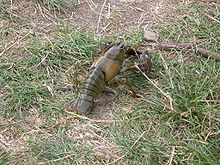- Crayfish plague
-
Crayfish plague Scientific classification Domain: Eukaryota Kingdom: Chromalveolata Phylum: Heterokontophyta Class: Oomycetes Order: Saprolegniales Family: Leptolegniaceae Genus: Aphanomyces Species: A. astaci Binomial name Aphanomyces astaci
Schikora, 1906 [1]Crayfish plague, Aphanomyces astaci, is a water mould that infects crayfish, most notably the European Astacus which dies within a few weeks of being infected. When experimentally tested, species from Australia, New Guinea and Japan were also found to be susceptible to the infection.[2]
Contents
History
Crayfish plague first arrived in Europe in Italy in 1859, either with imported crayfish from North America,[3] or in ballast water.[4] After its original introduction in Italy in 1860, it spread quickly through Europe and was discovered in Sweden in 1907, in Spain in 1972, in Norway in 1971, in Great Britain in 1981, in Turkey in 1984 and in Ireland in 1987.
In 1959, to bolster dwindling stocks of native crayfish, the signal crayfish was introduced to Sweden.[3] The signal crayfish was known to be resistant, and it was not recognised at that time that it was a carrier of the disease.[3] After 150 years of contact, no resistance has been discovered in native European crayfish.[5]
Transmission
Implantations of the signal crayfish was the reason for the spread of the disease to United Kingdom and Ireland. Transport of signal crayfish, red swamp crayfish and infected native European freshwater crayfish between waters is the main cause for contamination. Transmission of the disease through items that has been in contact with contaminated water, for example a fishing tool or footwear is also possible.[6] The spores are also sensitive to high or low temperatures. Most authorities have local rules and regulations that the amount of water moved between different waters (in for example a boat) is minimised. It is usually also recommended to only use fishing bait from the same lake when fishing, alternatively freeze it to at least −10 °C (14 °F) for one day before use, if risk for contamination exists. The fungal spores of crayfish plague disappear from an infected water system (connected lakes and rivers) in a few weeks after the last infected crayfish is gone.[6] Reintroduction is then possible, as long as no infected waters are in contact with the lake.
Signs
Infection with Aphanomyces astaci is accompanied by few signs in its early stages, and the first indication of infection may be mortality.[7] In the later stages, the muscles of the tail may appear whitened, or brownish-red where blood cells have encapsulated the hyphae. The effects of the neurotoxins in the oömycete can include appearing in daytime (crayfish are typically nocturnal) and a lack of co-ordination.[7]
References
- ^ Paul Kirk (2010). "Aphanomyces astaci Schikora, 1906". World Register of Marine Species. http://www.marinespecies.org/aphia.php?p=taxdetails&id=394837. Retrieved June 29, 2011.
- ^ Susan M. Bower (June 28, 2006). "Crayfish plague (fungus disease)". Synopsis of Infectious Diseases and Parasites of Commercially Exploited Shellfish. Fisheries and Oceans Canada. Archived from the original on December 12, 2008. http://web.archive.org/web/20081212165759/http://www.pac.dfo-mpo.gc.ca/sci/shelldis/pages/cpfdcy_e.htm. Retrieved June 29, 2011.
- ^ a b c Christian Nellemann & Emily Corcoran, ed (2010). "Restoration of a depleted crayfish fishery in Europe – lessons learnt" (PDF). Dead Planet, Living Planet: Biodiversity and Ecosystem Restoration for Sustainable Development. UNEP / Earthprint. p. 90–91. ISBN 978-82-7701-083-0. http://books.google.co.uk/books?id=irLBX-3nBEQC&pg=PA90.
- ^ Kei Westman (2002). "Alien crayfish in Europe: negative and positive impacts and interactions with native crayfish". In Erkki Leppäkoski, Stephan Gollasch & Sergej Olenin. Invasive Aquatic Species of Europe: Distribution, Impacts, and Management. Springer. pp. 76–95. ISBN 9781402008375. http://books.google.co.uk/books?id=KkQoxh2oXc8C&pg=PA76.
- ^ David Alderman (December 18, 2006). "Aphanomyces astaci" (PDF). Delivering Alien Invasive Species Inventories for Europe. http://www.europe-aliens.org/pdf/Aphanomyces_astaci.pdf. Retrieved June 29, 2011.
- ^ a b "Crayfish plague". Environment Agency. June 2, 2011. Archived from the original on September 21, 2008. http://web.archive.org/web/20080921083819/http://www.environment-agency.gov.uk/subjects/fish/246986/342184/1205879/1205996/?lang=_e. Retrieved June 29, 2011.
- ^ a b Nicky Buller (September 2008). "Crayfish Plague" (PDF). Australia and New Zealand Standard Diagnostic Procedure. Sub-Committee on Animal Health Laboratory Standards. http://www.scahls.org.au/__data/assets/pdf_file/0004/1516513/Crayfish_Plague.pdf.
External links
- "Crayfish plague". Environment Agency. June 2, 2011. http://www.environment-agency.gov.uk/homeandleisure/recreation/fishing/38053.aspx.
- Global Invasive Species Database
- Canadian Fisheries and Oceans Crayfish Plague information
- Trade Environment Database Case Study on Crayfish Plague
Categories:- Water moulds
- Crayfish
- Diseases and parasites of crustaceans
Wikimedia Foundation. 2010.

